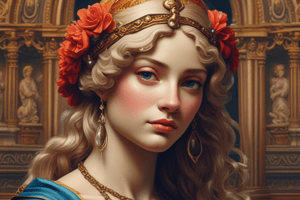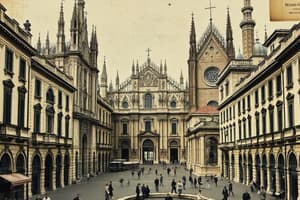Podcast
Questions and Answers
Why was the term 'Renaissance' used to refer to the time between 1350 and 1550?
Why was the term 'Renaissance' used to refer to the time between 1350 and 1550?
It was believed to be the rebirth of ancient Greek and Roman worlds.
What are the three most important characteristics of the Italian Renaissance?
What are the three most important characteristics of the Italian Renaissance?
Urban society, recovery from 14th-century disasters, and emphasized individual ability.
Which three city-states played crucial roles in Italian politics?
Which three city-states played crucial roles in Italian politics?
Milan, Venice, and Florence.
How did the location of Milan help to make it rich and powerful?
How did the location of Milan help to make it rich and powerful?
What activities in Florence did the Dominican preacher Savonarola seek to regulate?
What activities in Florence did the Dominican preacher Savonarola seek to regulate?
Which two European countries made Italy their battleground for 30 years?
Which two European countries made Italy their battleground for 30 years?
Why did the army of Charles I of Spain sack the city of Rome in 1527?
Why did the army of Charles I of Spain sack the city of Rome in 1527?
What has been the impact of Niccolò Machiavelli's book 'The Prince'?
What has been the impact of Niccolò Machiavelli's book 'The Prince'?
From Machiavelli's point of view, what attitude should a prince have toward power?
From Machiavelli's point of view, what attitude should a prince have toward power?
What did Castiglione say were the three characteristics of a perfect Renaissance noble?
What did Castiglione say were the three characteristics of a perfect Renaissance noble?
How did Italian families have their children declared adults?
How did Italian families have their children declared adults?
A system in which cities are the center of political, economic, and social life is called _____.
A system in which cities are the center of political, economic, and social life is called _____.
What does the term 'secular' mean?
What does the term 'secular' mean?
What is a mercenary?
What is a mercenary?
What is a dowry?
What is a dowry?
What is humanism?
What is humanism?
Humanists used the works of _____ as a model for prose and those of _____ for poetry.
Humanists used the works of _____ as a model for prose and those of _____ for poetry.
What is 'The Divine Comedy' by Dante about?
What is 'The Divine Comedy' by Dante about?
What is 'The Canterbury Tales'?
What is 'The Canterbury Tales'?
What do liberal studies aim to do?
What do liberal studies aim to do?
Who were the focus of attention in Renaissance art?
Who were the focus of attention in Renaissance art?
How did painters, sculptors, and architects portray the world around them?
How did painters, sculptors, and architects portray the world around them?
Who are associated as artistic giants in the Italian High Renaissance?
Who are associated as artistic giants in the Italian High Renaissance?
Who was Jan van Eyck?
Who was Jan van Eyck?
Who studied Italian techniques?
Who studied Italian techniques?
Study Notes
Renaissance Overview
- The term "Renaissance" refers to a period believed to signify the rebirth of classical Greek and Roman cultures, spanning from 1350 to 1550.
Characteristics of the Italian Renaissance
- An urban society emerged, recovering from 14th-century calamities, emphasizing individual abilities and achievements.
Key Italian City-States
- Milan, Venice, and Florence were pivotal city-states in shaping Italian politics during the Renaissance.
Geographic Advantage of Milan
- Milan's strategic location at trade crossroads contributed to its wealth and power.
Regulation by Savonarola
- Dominican preacher Savonarola attempted to regulate various activities in Florence, including gambling, horse racing, swearing, painting, music, and literature.
Foreign Involvement in Italy
- France and Spain transformed Italy into a battleground for 30 years, impacting its political landscape.
Sacking of Rome
- Charles I of Spain's army sacked Rome in 1527 primarily for its treasures and financial gains.
Machiavelli's Impact
- Niccolò Machiavelli's work, "The Prince," shifted political thought by suggesting that morality is not a defining principle in politics.
Machiavelli's View on Power
- Machiavelli believed a prince should base his power on an understanding of human nature to effectively govern.
Characteristics of the Perfect Noble
- According to Castiglione, a perfect Renaissance noble is characterized by noble lineage, warrior skills, and adherence to proper conduct standards.
Declaration of Adulthood
- Italian children became adults when their fathers formally freed them in front of a judge.
Urban Society Definition
- Urban society is characterized by cities serving as the centers of political, economic, and social life.
Secular Meaning
- The term "secular" refers to worldly matters, distinct from religious contexts.
Definition of Mercenary
- A mercenary is defined as a soldier who sells his military services to the highest bidder.
Concept of Dowry
- A dowry is a financial gift provided at marriage, either from a bride's parents to her husband or vice versa in Islamic traditions.
Key Intellectual Movement
- Humanism emerged as a major intellectual movement during the Renaissance, focusing on human potential and achievements.
Influential Figures in Humanism
- Humanists drew upon the works of Cicero for prose and Virgil for poetry as foundational texts.
Purpose of "The Divine Comedy"
- Dante's "The Divine Comedy" narrates the journey of the soul toward salvation.
Structure of "The Canterbury Tales"
- "The Canterbury Tales" is a collection of stories narrated by 29 pilgrims traveling to Saint Thomas a Becket's tomb.
Objectives of Liberal Studies
- The liberal studies curriculum aimed to guide individuals on the paths of wisdom and virtue during the Renaissance.
Focus of Renaissance Art
- Renaissance art centered predominantly on humans, capturing human emotion and experience.
Realism in Art
- Painters, sculptors, and architects of the Renaissance portrayed their surroundings in a realistic manner, emphasizing detail and perspective.
Artistic Masters of the High Renaissance
- Leonardo da Vinci, Raphael, and Michelangelo are celebrated as the leading figures of the Italian High Renaissance.
Jan van Eyck's Contribution
- Jan van Eyck was one of the first Flemish painters to utilize oil paint, enhancing the depth and richness of color in artworks.
Influence of Italian Techniques
- Artists from Northern Europe studied and incorporated Italian artistic techniques into their own works, merging styles and traditions.
Studying That Suits You
Use AI to generate personalized quizzes and flashcards to suit your learning preferences.
Description
Explore the fundamental aspects of the Renaissance era, which marked a significant rebirth of classical cultures from 1350 to 1550. This quiz covers the characteristics of Italian city-states such as Milan, Venice, and Florence, as well as key figures and events that influenced the period.




